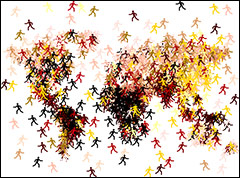
Scholars, policy analysts, and even military officers are breaking down climate change’s impacts into what they hope are more manageable topics for examination. The migration that climate change could cause is one such topic. For instance, the Center for American Progress recently posted a piece entitled “Climate Refugees: Global Warming will Spur Migration.” The International Peace Academy analyzed “Climate Change and Conflict: The Migration Link” (PDF) in a May 2007 Coping With Crisis working paper. Climate change-induced migration also figured prominently in the security perspective offered by the CNA Corporation’s Military Advisory Board in its report, “National Security and the Threat of Climate Change.”
In many respects, these pieces are careful in their discussion of the topic. But allow me a few words of caution on climate change and migration, based on what we learned from a series of programs on the topic in the late 1990s here at the Environmental Change and Security Program at the Woodrow Wilson Center.
First, the use of the term “refugee” is convenient but problematic.
In order to achieve refugee status, people must be fleeing persecution or violence and must cross a national border. Countries are then obligated by international law to admit them, provide shelter, and so forth. Notably, then, the definition of “refugee” is based on political boundaries and has nothing to offer internally displaced persons. It also does nothing for people who are "pulled" for economic reasons or "pushed" for environmental reasons. Because not all people displaced by climate change will be fleeing violence or crossing a national border, it is critical to avoid referring to them as refugees if one wants to be taken seriously by the UN, lawyers, academics, and governments. Governments, in particular, have a fairly strong interest in keeping the definition narrow because of the obligations they have to refugees. For this reason, the “knee-jerk” reaction for most of them will be to resist granting refugee status to a new large group of people.
The second problem is that the motivations for migration are multiple, and distinguishing between economic pulls and environmental pushes is very difficult. A farmer suffering from prolonged drought is both pushed to move from his land and pulled to an urban area or to more fertile ground by the promise of greater economic opportunity. This is self-evident, of course, but when the situation is reduced to "climate migrants" versus "economic migrants," the response from climate change skeptics will always be: "They are just economic refugees." One can easily see this classification problem with Mexican migrants coming across the border to the United States to work. Are they climate migrants because their homes have experienced prolonged drought that may have been exacerbated by climate change? Or are they economic migrants who are "just coming for our jobs"? The multicausality of the motivations for moving makes labeling a migrant with any single adjective (political, economic, environmental, climate, etc.) problematic.
The third difficulty — which follows from the challenge of multicausality — is that it is extraordinarily difficult to develop and defend a methodology for calculating the number of climate migrants. A prominent biologist who spoke at the Wilson Center in the mid-1990s claimed that the number of climate refugees could be in the tens of millions. When one participant asked him how he determined who was in and who was out of his total, his response was basically: I read a lot of reports and this is my best guess. Naturally, the air went out of the room, and we might as well have ended the meeting right then. This is the danger of asserting that there are millions more climate migrants than political refugees from war or persecution. For starters, is the number of climate migrants being compared with the legal category of refugees, or does the comparison also factor in the millions of war-induced internally displaced persons? If this kind of comparative analysis isn’t done carefully, some will believe that the climate-change migration numbers have been exaggerated by a flawed methodology. This issue will then be in danger of being unfairly marginalized.
I say “unfairly” because I believe climate change could have a tremendous effect on human migration. Even though we cannot parse out a single cause, climate changes are still critical pushes that cause people to move. Migration — like conflict and other social phenomena — is by definition multicausal. Just as "environmental conflict" theories that privileged environmental scarcity as the explanation for civil conflict were criticized, so too is the "climate refugee" argument open to critique.
The most nuanced conflict work now being done focuses on how environmental scarcity or abundance can exacerbate more proximate causes of conflict such as ethnic difference or relative deprivation. Likewise, the key to getting climate on the table as a principal driver of migration is to carefully trace how it interacts with the many other factors that cause people to move.
Climate and migration links may prove to be effective arguments in the larger political discussions of climate change mitigation. That is clearly the way the Center for American Progress is deploying them. Raising migration (and its potentially negative impacts on security, which the CNA report highlights) as an additional cost of inaction may be effective in some political settings. But to maintain a focus on improving the lives of people on the ground, it is crucial to translate this larger theoretical and political argument into a variety of specific interventions. Then, when donors, NGOs, and host governments become convinced of the challenges presented by climate and security linkages, there will be a full menu of responses to offer and implement.


